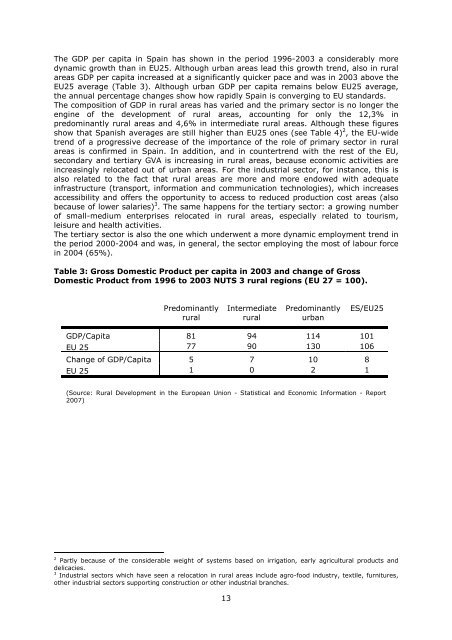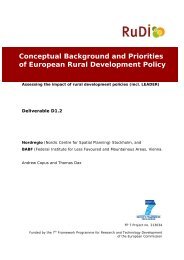Country profile on rural characteristics Spain - RuDI
Country profile on rural characteristics Spain - RuDI
Country profile on rural characteristics Spain - RuDI
- No tags were found...
Create successful ePaper yourself
Turn your PDF publications into a flip-book with our unique Google optimized e-Paper software.
The GDP per capita in <strong>Spain</strong> has shown in the period 1996-2003 a c<strong>on</strong>siderably moredynamic growth than in EU25. Although urban areas lead this growth trend, also in <strong>rural</strong>areas GDP per capita increased at a significantly quicker pace and was in 2003 above theEU25 average (Table 3). Although urban GDP per capita remains below EU25 average,the annual percentage changes show how rapidly <strong>Spain</strong> is c<strong>on</strong>verging to EU standards.The compositi<strong>on</strong> of GDP in <strong>rural</strong> areas has varied and the primary sector is no l<strong>on</strong>ger theengine of the development of <strong>rural</strong> areas, accounting for <strong>on</strong>ly the 12,3% inpredominantly <strong>rural</strong> areas and 4,6% in intermediate <strong>rural</strong> areas. Although these figuresshow that Spanish averages are still higher than EU25 <strong>on</strong>es (see Table 4) 2 , the EU-widetrend of a progressive decrease of the importance of the role of primary sector in <strong>rural</strong>areas is c<strong>on</strong>firmed in <strong>Spain</strong>. In additi<strong>on</strong>, and in countertrend with the rest of the EU,sec<strong>on</strong>dary and tertiary GVA is increasing in <strong>rural</strong> areas, because ec<strong>on</strong>omic activities areincreasingly relocated out of urban areas. For the industrial sector, for instance, this isalso related to the fact that <strong>rural</strong> areas are more and more endowed with adequateinfrastructure (transport, informati<strong>on</strong> and communicati<strong>on</strong> technologies), which increasesaccessibility and offers the opportunity to access to reduced producti<strong>on</strong> cost areas (alsobecause of lower salaries) 3 . The same happens for the tertiary sector: a growing numberof small-medium enterprises relocated in <strong>rural</strong> areas, especially related to tourism,leisure and health activities.The tertiary sector is also the <strong>on</strong>e which underwent a more dynamic employment trend inthe period 2000-2004 and was, in general, the sector employing the most of labour forcein 2004 (65%).Table 3: Gross Domestic Product per capita in 2003 and change of GrossDomestic Product from 1996 to 2003 NUTS 3 <strong>rural</strong> regi<strong>on</strong>s (EU 27 = 100).Predominantly<strong>rural</strong>Intermediate<strong>rural</strong>PredominantlyurbanES/EU25GDP/Capita 81 94 114 101EU 25 77 90 130 106Change of GDP/Capita 5 7 10 8EU 25 1 0 2 1(Source: Rural Development in the European Uni<strong>on</strong> - Statistical and Ec<strong>on</strong>omic Informati<strong>on</strong> - Report2007)2 Partly because of the c<strong>on</strong>siderable weight of systems based <strong>on</strong> irrigati<strong>on</strong>, early agricultural products anddelicacies.3 Industrial sectors which have seen a relocati<strong>on</strong> in <strong>rural</strong> areas include agro-food industry, textile, furnitures,other industrial sectors supporting c<strong>on</strong>structi<strong>on</strong> or other industrial branches.13



